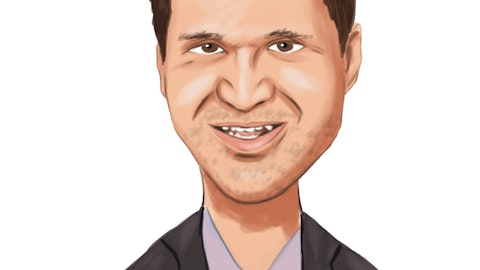WSFS Financial Corporation (NASDAQ:WSFS) Q4 2022 Earnings Call Transcript January 27, 2023
WSFS Financial Corporation beats earnings expectations. Reported EPS is $1.38, expectations were $1.36.
Operator: Welcome to the WSFS Financial Corporation Fourth Quarter 2022 Earnings Call. . I’d now like to turn the call over to your host for today, Mr. Dominic Canuso, Chief Financial Officer. Sir, you may begin.
Dominic Canuso: Thank you, Angela, and thanks to all of you for taking the time to participate on our call today. With me on this call are Rodger Levenson, Chairman, President and CEO; Art Bacci, Chief Wealth Officer; Steve Clark, Chief Commercial Banking Officer; and Shari Kruzinski, Chief Consumer Banking Officer. Before I begin with the remarks on the quarter, I would like to read our safe harbor statement. Our discussion today will include information about our management’s view of our future expectations, plans and prospects that constitute forward-looking statements. Actual results may differ materially from historical results or those indicated by these forward-looking statements due to risks and uncertainties, including, but not limited to, the risk factors included in our annual report on Form 10-K and our most recent quarterly reports on Forms 10-Q as well as other documents we periodically filed with the Securities and Exchange Commission.
All comments made during today’s call are subject to the safe harbor statement. I will now pass the call over to Rodger.
Rodger Levenson: Thanks, Dominic. Consistent with our recent practice on the fourth quarter earnings call, our remarks today will be divided into 2 sections. I will provide brief commentary on the fourth quarter and full year 2022 results and then turn it over to Dominic for our 2023 outlook. After our prepared remarks, we will open it up for Q&A with the team. 2022 was an important year for WSFS. Since the closing of our combination with Bryn Mawr Trust, last January, we built momentum and our financial performance improved each quarter, culminating with the strong fourth quarter. This past quarter’s results were highlighted by our core net interest margin of 4.49%, which expanded 50 basis points or 13% higher than the third quarter.

Photo by Tierra Mallorca on Unsplash
Loan growth was solid, and we continued to exhibit the value of our diversified fee increase. The trend of absorption into the economy of the excess liquidity build up during 2020 and 2021 was evidenced by the decline in deposits. Excluding lower institutional trust deposits due to reduced capital markets activity and normal seasonal runoff of municipal deposits, total customer deposits declined approximately 2% linked quarter or 6% annualized. Credit costs were modestly higher due to loan growth and the economic forecast and all credit metrics remain at favorable levels. Expenses remain well managed and reflects the continued impact of higher rates on Cash Connect funding expenses that are offset in our fee revenue. In summary, our operating performance improved significantly from the third quarter with core EPS, core ROA and core PPNR increasing 12%, 13% and 14%, respectively.
Although we expect economic growth to be muted in the near term, we enter 2023 with the BMT Bank integration activity successfully completed and positioned very well to optimize the significant franchise investments over the past several years. Dominic?
Dominic Canuso: Thanks, Rodger. On Slide 4 of the earnings release supplement presentation, which is available in the Investor Relations section of our company website, we lay out our expectations and outlook for 2023, which I will walk through now. Our assumptions are based on a relatively flat yield environment with Fed funds ending the year at 4.75% and flat GDP growth with mild recessionary growth rates in the second half of the year. Net loan growth is expected to be in the mid-single digits with growth across all of our lending portfolios. Consistent with our current loan mix, C&I lending is expected to be a meaningful contributor to overall growth, along with our continued success from our NewLane leasing business both driving the mid- to high single-digit growth in our total commercial portfolio.
While remaining excess liquidity could result in some elevated payoffs. Portfolio pipelines and our competitive market position provide for anticipated continued growth. We expect the consumer loan portfolio growth to moderate in 2023 relative to 2022 in consideration of the overall economic outlook. Deposits are expected to remain relatively flat by year-end. While we have benefited meaningfully from our customers’ outsized excess liquidity, demonstrated by our lower-than-peer average loan-to-deposit ratio, including the current quarter 73%. We anticipate this to normalize throughout 2023. Of course, our expectations are subject to somewhat unpredictable nature of the current macro liquidity environment. With that said, we have a well diversified and loyal customer base across all of our primary businesses, and we will be competitive and prudent in our deposit pricing to retain our existing customers where appropriate and to grow new customers.
This is consistent with our performance to date as demonstrated by our through-the-cycle beta of 15%, which we expect to increase to approximately 35% by the end of the year. As we have discussed over the past 2 years, our strategy has been to deploy excess liquidity into our investment portfolio, which historically was in our target range of 16% to 18% of total assets and has grown to be in the high 20%. this has provided optionality given the unpredictable nature of the environment and has served us well, generating over $40 million of pretax income in 2022. With the normalization of excess liquidity, we will let the investment portfolio cash flow back down to our target level to fund loan growth. The portfolio currently cash flows at a run rate of approximately $500 million to $600 million per year.
Full year net interest margin is expected to be in the 4.35% to 4.45% range. We are assuming 225 basis point increases in short-term rates early in the year, followed by 125 basis point decrease late in the year. We will continue to benefit from our predominantly variable loan portfolio and the asset mix shift from our investment portfolio to loans. These will be offset by the previously mentioned deposit betas and a return to a modest level of wholesale borrowings. Core fee revenue growth is expected in the mid- to high single digits driven by Cash Connect’s variable rate fee pricing and franchise growth and also supported by modest growth in mortgage banking and capital markets. Our fee income is expected to continue its resiliency through these economic and interest rate environments, generating a core fee revenue ratio in the mid- to high 20%.
Provision costs are expected to be between 40 to 50 basis points of average loans for the year primarily driven by loan growth and the forecasted economic environment. This is supported by the beginning of the year with strong current and leading portfolio credit metrics and an ACL coverage ratio of 1.17%. Our core efficiency ratio is expected to be in the mid-50s as we continue to invest prudently into the growth of the overall franchise, particularly in talent and benefits and our technology stack to enable internal efficiencies and scale and to continue to enhance our customer experiences across our delivery channels. 2023 full year core ROA outlook is around 1.50%, with a robust PPNR as a percentage of assets of around 2.3%, which reflects the strength of our business model, including our broad lending products and the highly diversified and resilient fee revenue base.
2023 continues the momentum from 2022 and we are excited about the strong growth potential from our unique strategic market position in both our regional and national franchises. We will now open the line to answer any questions you may have.
See also 15 Most Undervalued Large-cap Stocks To Buy and 15 Most Undervalued Quality Stocks To Buy.
Q&A Session
Follow Wsfs Financial Corp (NASDAQ:WSFS)
Follow Wsfs Financial Corp (NASDAQ:WSFS)
Receive real-time insider trading and news alerts
Operator: . Your first question comes from the line of Frank Schiraldi with Piper Sandler.
Frank Schiraldi: Just — Dominic, on the mid-single digit or the guide in general on the mid-single-digit loan growth and then utilizing the cash flow from the securities book. It seems to me they’re pretty much, I don’t know, perfectly offsetting. So you also mentioned, I think, some modest level of borrowings. So I just wanted to make sure just in terms of modeling. I’m kind of thinking about it for a click.
Dominic Canuso: Yes, I think you summarized the calculus of how they come together. The question will be the phasing throughout the year. So we do expect — while the cash flowing of the investment portfolio is between $40 million to $50 million a month, the phasing of the loan growth might result in a different pace of that. And we are anticipated to fund that depending on the excess liquidity runoff with wholesale borrowings.
Frank Schiraldi: Okay. And then in the past, when you guys have talked about loan growth, you’ve excluded resi runoff. I don’t know if maybe that’s just sort of almost complete now. So it just doesn’t move the needle or what’s the thinking there?
Dominic Canuso: Yes. As you may recall, since beneficial and through BMT, we’ve had some runoff portfolios, including the acquired residential portfolio. For the most part, they have run their course, and the remaining acquired residential portfolio is nominal relative to attrition rate to impact the entire story, plus in select places and working with some of our customers, we are retaining some ARM mortgages that will supplement that portfolio. So we’re now at a point where we’ll be speaking to total loan growth from here on out.
Frank Schiraldi: Okay. Great. And then just lastly, you talked about the efficiencies in mid-50s on the higher revenue guide was a little surprising to me, but you mentioned the further investment into the franchise. Just wondering if that’s — I guess, first, is that sort of a reasonable place to expect WSFS to operate in the longer term? And then also, does that assume any cost saves in the Wealth Management business in 2023 following the merger? Or is that something that’s further out?
Dominic Canuso: Sure. So parse those out. We would expect mid-50s to be a sustainable level of efficiency ratio particularly for 2 reasons: our high-touch customer service levels across our banking franchise and our outsized fee income ratio. And as we know, both in Wealth and Cash Connect, there’s a higher than bank average efficiency ratio in those businesses. So — and we continue to invest across all those opportunities. I do think our step-off point was particularly low from 2022 because of the higher vacancy factor from the labor markets. And then lastly, on the synergies we have achieved all of the BMT cost synergies that we anticipated, almost all of them were from the bank side. There were some from the wealth side, but they’ve all been included in our run rate. The business does continue to look for operational opportunities, but no restructuring benefits.
Operator: Your next question comes from the line of Feddie Strickland with Janney Montgomery Scott.
Feddie Strickland: I was just curious with respect to loan guidance, should we expect loan growth to be more heavily weighted towards the earlier part of the year assuming an economic slowdown later in the year? Or do you think it will be fairly consistent?
Stephen Clark: Feddie, this is Steve Clark speaking. I think our pipeline has been pretty consistent, the 90-day weighted average for the past several quarters of just under $300 million. So that’s our expectation going forward. No real front loading. We’re hoping that we’ll continue to have a fairly robust pipeline and generate loan growth through the whole year.



